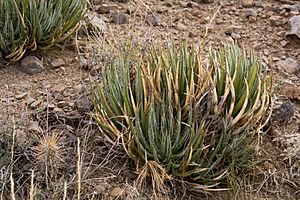Schott's century plant facts for kids
Quick facts for kids Schott's century plant |
|
|---|---|
 |
|
| Habit of Agave schottii | |
| Conservation status | |
| Scientific classification | |
| Genus: |
Agave
|
| Species: |
schottii
|
| Synonyms | |
|
|
Agave schottii, often called Schott's century plant, is a cool shrub. It belongs to the Agave plant family. This plant is a type of succulent, meaning it stores water in its leaves. There are two main types, or varieties, of Agave schottii.
Contents
Where it Lives
Agave schottii is found in North America. You can see it in the United States of America, in Arizona and New Mexico. In Arizona, it grows in the southern parts of the state. In New Mexico, it's only found in a small southwestern area.
This plant also grows in Mexico, in the states of Chihuahua, Sonora, and Baja California. One special type, Agave schottii var. treleasei, is very protected. It only grows in Pima County, Arizona.
Its Home and How it Grows
This plant loves dry places. It grows on sunny, rocky slopes or in small valleys. You can find it in high desert areas, grasslands, and forests with juniper and oak trees. It prefers slopes that face north or east. These spots stay cooler than slopes facing direct sunlight. Agave schottii grows at elevations from about 1,100 to 2,000 meters high.
What it Looks Like
Agave schottii is a flowering shrub. Like other Agave plants, it's a succulent. It has thick, blue-green leaves that look like fingers. These leaves have sharp spines at their tips.
What makes Agave schottii special is that its leaves do not have spines along their edges. The leaves usually grow to be about 0.3 meters (about one foot) long. Because it's short and has sharp leaves, people sometimes call it "shindagger."
The plant's flowers are pale to bright yellow. They grow on branches from a main stem. The flowers are shaped like tubes and are small. Some types of this plant have flowers that grow in a different pattern. The flowers of Agave schottii smell very sweet and pleasant.
After flowering, Agave schottii produces dry fruits called capsules. These capsules split open to release the seeds.
Pollination
Like most Agave plants, Agave schottii flowers are pollinated by many different creatures. These include bats, butterflies, moths, bumblebees, honeybees, and hummingbirds.
Agave schottii produces a small amount of sweet liquid called nectar each day. It makes most of its nectar at night. This suggests that bats might be important pollinators. However, its yellow flowers, sweet smell, and low protein in the nectar also suggest insects or birds help pollinate it.
Reproduction and Life Cycle
Agave schottii is a clonal plant. This means it can make copies of itself. It can produce new plants that are exactly like the parent plant. This is a type of asexual reproduction.
However, this plant also likes to breed with other Agave schottii plants. This is called outcrossing. It helps create new plants with more variety in their genes. The best distance for these plants to cross-breed is between 10 and 100 meters. If plants breed too close, their offspring have less genetic variety. If they breed too far apart, they might not be a good match.
How People Use It
Agave plants in general have many uses. They can be used as a sweetener or to make tequila. Some Agave plants even have properties like an antibiotic.
Agave schottii itself has a very bitter taste. Because of this, people and animals usually don't eat it. The bitter taste comes from special chemicals in the plant. These chemicals make it useful as a soap!
The soap made from Agave schottii is called "amole" by Spanish-speaking people. Native groups, like the Seri people, also use it. The Seri people call it "ikapanniim," which means 'to wash hair with.' They use it as a shampoo to clean and soften their hair. They also use it to wash clothes.
Scientists are also studying the chemicals in Agave schottii. They want to see if these chemicals could help in anti-cancer treatments.


